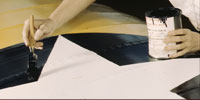ON THE HOMEFRONT
As the war effort swung into full effect, many of the men who would fill positions on the assembly line had taken up positions within the military. This in turn had left a large hole in the workforce. Therefore, many women stepped up their efforts to fill the void. They worked in the war industry, riveting skin onto aircraft, milling steel for mulitions and sewing uniforms for troops. Even my grandmother participated in this effort, working at the cafeteria of a General Motors facility during the war.
But it did not mean that all women were employed in war time industry. The United States government ran many programs in which men and women at home could participate. Victory gardens were one of these efforts, where families could grow produce for their own home consumption, which would then allow surplus produce to be used towards troop supplies.
Men too were asked to participate in efforts on the home front. There was a civilian defense corps, for protection of the homeland if it was invaded. And all were asked to keep their eyes and ears open for spies, and their mouths shut as it pertained to wartime secrets. Everyone could play their part to mobilize our nation.



